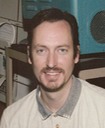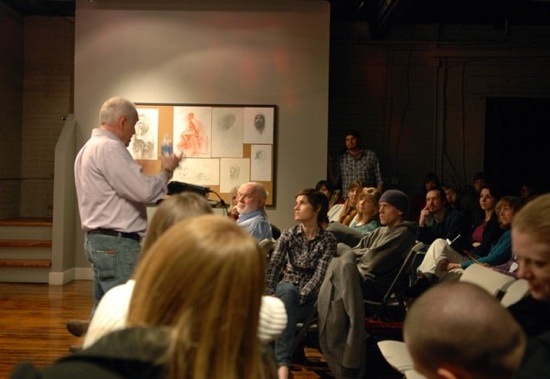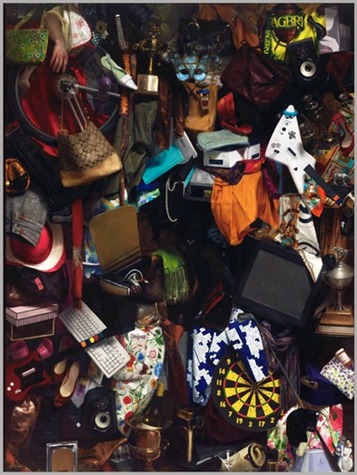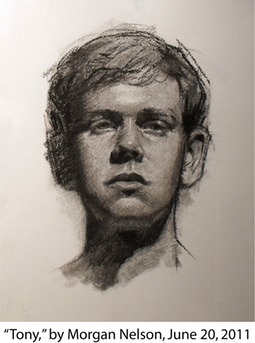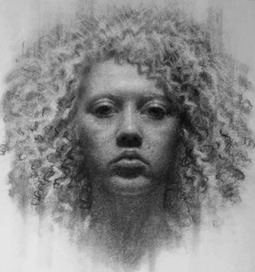This section includes the following:
• Notes from a Marshall Vandruff Lecture.
• Notes from a Scott Gustafson Lecture.
• Notes from a James C. Christensen Lecture.
• Notes from Jeff Hein’s unveiling of “Consumed.”
• Notes from the viewing of Arnold Friberg.
• Notes from an interview of Marshall Vandruff.
• Notes from a demonstration by Morgan Nelson.
• Notes from Jeff Hein’s unveiling of “As a Hen Gathereth.”
• Notes from Jeff Hein’s portrait painting demonstration.
• Notes from Rose Datoc Dall's portrait painting demonstration.
Marshall Vandruff Lecture, “Classic Draftsmanship,” November 28, 2009, Brea, California.
• Web Site: http://www. marshallart.com
• Perspective: The foundation of all that you draw.
• The Science of Perspective = Magic.
• "Drawing Lessons from the Great Masters," Robert Beverly Hale.
• Cross Contours (rubber bands) -- shows the perspective.
• Draftsmanship: the creation of the optical illusion of a 3-D object on a flat, 2-D surface.
• Drew Struzan, quote from about 1990: "People don't know how to draw; they copy photography. Can anyone draw? Don't be bound by reference."
• Begin simply.
• Shapes to Forms.
• Jon Gnagy.
• Glenn Vilppu.
• If it's good enough for Rembrandt, it's good enough for us.
• Glass, center lines, height, width, depth.
• The secret of classic draftsmanship:
Learn the simple forms (box, cylinder, cone, wedge, sphere).
Master the simple forms.
Assemble the simple forms.
Shade the simple forms.
• Basic Skills:
Spin a box.
Tilt a cylinder.
• Draw lines on the other side ("see through").
• Rubber Bands / French Bread (cut ends) / Boxes.
• The fear of foreshortening.
• Exaggerate the foreshortening in 3/4 views.
• Planes of the head.
• Copy master drawings.
• The sphere: the most basic form in nature.
• Cross contours are lines on simple forms.
• Teaching: an excuse to learn.
• "Facial Expressions," Gary Faigin.
• Stripes on beach balls, rings around barrels.
• Center Lines / Center Line Construction.
• Cross Contours.
• Wire Frame.
• Ellipses don't come to a point; symmetrical left to right and top to bottom.
• Draw everything like it's made out of glass and has steam in it.
• Buy more "Dover" books.
• Gradual refinement.
• Japanese Proverb: "Acquire an infallible technique, then open yourself to inspiration" (then do anything you want).
• "The Natural Way to Draw," Kimon Nicolaides.
Scott Gustafson Lecture, December 4, 2009, Farmington, Utah.
• Web Site: http://www.scottgustafson.com/
• Hometown: Chicago
• Occupation: Freelance Illustrator
• Influences:
Warner Bros. Cartoons
Disney’s “Pinocchio”
J.C. Leyendecker
Norman Rockwell
N.C. Wyeth
Howard Pyle
John Tenniel
Arthur Rackham
• Illustrated books mentioned in lecture:
Pinocchio (never completed).
The Night Before Christmas (Built reindeer maquette to observe perspective of differently positioned reindeer.)
• LOTR / The Hobbit note: Completed two LOTR painting (“Bilbo’s Door, “ “The Unexpected Party”). Refused additional illustration assignments on Tolkien’s works because of the time and complexities involved in the illustrations.
• Methods:
Reference Books.
Models (photographic reference).
Uses copy machine to re-size / re-position elements within an illustration.
Small color roughs.
Masonite coated with Gesso.
Matte medium.
Acrylic stain (raw sienna).
Underpainting.
Background first; works back to front (characters live in the background).
Final painting in oil.
• Slides of influences, and slides of works from beginning to finish (Alice in Wonderland).
James C. Christensen Lecture, March 5, 2010, Provo, Utah.
On Friday, March 5, 2010, I attended a lecture by James C. Christensen at the Bridge Academy of Art in Provo, Utah. A truly fascinating experience. Below I’ve included some notes I took from his lecture:
• Influences:
Northern Renaissance
quirky perspective
attention to detail
Bosch
Brueghel
Durer
19th Century Romantics / Pre-Raphaelites
Leighton
Waterhouse
Dore
• Paints “slower than the drift of continents.”
• ”The harder you work, the luckier you’ll get.”
• Likes the work of Andrej Dugin and Olga Dugina.
• According to BYU professor Martha Peacock, “He (JCC) was born in the wrong century.”
• William Whitaker, a fellow professor at BYU, taught him how to paint in oils.
• Has a hard time working for money -- has to love what he’s doing; needs to be excited about it.
• Put in the time. Get good. 10,000 hours (Malcolm Gladwell’s “Outliers”) of practicing your craft is what it will take to get good.
• Worked on the murals for the Nauvoo Temple.
• Uses small sable hair brushes for his work in oil.
• Contributed to the book, “Star Wars: Visions.” He painted a Cantina scene from Mos Eisley on Tattoine.
• Making money on PRINTS (Greenwich Workshop) and the originals allows him to justify to amount of time that he puts into a painting.
•
Has 57 volumes of sketchbooks, works almost exclusively in ink, and
relies on them for ideas, working out compostions, observational
sketching, etc.
Below is a photo taken during the lecture by artist Justin Taylor of the Bridge Academy of Art. If you look closely, you’ll see me on the third row, my lovely wife is on my left in the dark jacket and magenta blouse.
Jeff Hein Demonstration and the Unveiling of “Consumed,” March 12, 2010, Salt Lake City, Utah.
On Friday, March 12, 2010, I attended a demonstration by Salt Lake City artist, Jeff Hein. At this event he drew a charcoal portrait and unveiled his latest painting, “Consumed,” which you can see below. Here are a few observations:
I loved entering his studio and being hit in the face with the smell of oil paint. Nothing smells more like “art” than oil paint.
Jeff Hein also teaches at his studio and various student works-in-progress were on display. Presumably, in the exact place where the students work on them. I was pleased to see quite a bit of work done from still-life arrangements and casts. In addition, many life drawing were posted on the walls. It was readily apparent that Jeff Hein believes in working from life, and in accurate representation of what the artist sees.
I loved looking at his collection of “casts.” I saw busts and casts of various other body parts. They were white, and appeared to have been used and handled. It’s good to know that others believe in the importance in drawing form three-dimensional objects, instead of just photographs.
I came primarily to watch Jeff Hein draw, along with maybe one hundred other people. I was impressed that he used two hands at once: Jeff Hein is left-handed and in his left hand he held a piece of charcoal, in his right hand a paper stump blender or kneaded eraser. It was fascinating to see him use both hands at the same time. I’m right handed and have never been able to use my left hand for anything other than to hold my paper to keep it from moving.
I absolutely loved that at the beginning he asked us to be quiet while he drew. Drawing takes tremendous concentration, and I’ve always been annoyed by talkative artists or students. I find that I can talk and draw at the same time when what I’m doing is simple or easy. But when it becomes complicated, I stop talking, so that my mind can focus on the task at hand. It was nice to know that Jeff Hein feels the same way.
As to his procedure, Jeff Hein began with an eye and worked outward. At the end of his demonstration, he had a very nice likeness.
Refreshments were provided and they were great.
Below is Jeff Hein’s painting, “Consumed.” It’s huge, measuring eight feet tall and six feet wide. It won the “Juror’s First Place Award” at the Springville Museum of Art’s Spring Salon in 2010. He painted this from a still-life arrangement that was at the studio for all to see. This means that every painted object you see below was real and arranged in the way you see it below. A truly monumental undertaking.
Links:
The Viewing of Arnold Friberg, July 9, 2010, Salt Lake City, Utah.
I
attended the viewing for Arnold Friberg on July 9, 2010. I felt
obligated as an admirer of his work, as a Mormon, and because I'm a
wanna-be artist. When I found out that his viewing would be at the LDS
Conference Center in the "Arnold Friberg Room," where many of his
originals were housed, I was determined to attend.
The "Arnold Friberg Room" houses the original twelve Book of Mormon paintings that were commissioned by the LDS Church in the 1950s. I had seen them many times in the Books of Mormon that I have owned over the years, and even more often when I gave them out as an LDS missionary in Sao Paulo, Brazil. I had also collected several cheap prints of his Book of Mormon paintings in the months before my mission. At that time I had aspirations at that time of becoming an Arnold Friberg-like artist. Sadly that has not come to pass.
I had never seen the original Book of Mormon paintings before, although I have been to the Conference Center before. At at his viewing I had a chance to take in their actual size, texture, and color, and came away very impressed. He did not work small; their size was as majestic as their subject matter. In my mind, many of the characters of the Book of Mormon are exactly as Friberg envisioned them: Lehi, Nephi, Laman, King Noah, Abinadi, and Captain Moroni.
I also had the chance to view the original of Friberg's painting of George Washington in "The Prayer at Valley Forge." I consider this to be the definitive image of George Washington. The painting portrays not only the likeness of Washington (and his horse), but also his character, and in whom he placed his faith and trust. That trust was placed in The Almighty, of course. Once again, the prints I'd seen of it did not do justice to its size, color, and texture. The original is awe-inspiring and reminds the viewer of the debt owed to the Founding Fathers of this country.
Arnold Friberg was what you might call a "concept artist" for Cecil B. DeMille's 1956 film, "The Ten Commandments." A couple "concept paintings" were on display, and I particularly enjoyed Friberg's portrait of Charlton Heston as "Moses, Prince of Egypt." Another interesting item was Charlton Heston's "Levite Robe" costume, placed on a display mannequin.
Also set up as temporary displays were other religious works, such as "Shepherds in the Fields," western paintings, works of the Royal Canadian Mounted Police (of which he was an honorary member), and a print of his portrait of Prince Charles I of Wales and his horse, Centennial. Portrait drawings of family members (children, grandchildren, and great grandchildren I presumed) were arranged near the center of the room.
Finally, Arnold Friberg himself rested near the eastern wall. Laid in his open coffin, dressed in a dark red jacket, with a short and neatly trimmed mustache, he looked quite peaceful.
I was extremely impressed at the physical evidence of Arnold Friberg's life: the things he left behind, the record of his work on this earth, his legacy. In this way, artists seem especially blessed to be able to leave tangible evidence of their sojourn on this earth.
I think I picked the best time to view the evidence of Arnold Friberg's mortal existence. Mormons who did not come missed out on paying their respects to one of their brothers to whom they are indebted for his visualization of characters who make up "the cornerstone of our religion." Those not of the Mormon faith who did not come, missed out on the chance to appreciate the artwork of a modern master.

CLICK to view a collection of Arnold Friberg’s artwork.
An Interview of Marshall Vandruff by Travis Bourbeau
Marshall Vandruff’s brand new “Introduction to Animal Anatomy” title was released this week at the Gnomon Workshop. While he was here recording I had a chance to inquire about his background and how he found himself working as an illustrator and teaching anatomy.
MV: I’ve lived all my life in Orange County, California, and when I was a kid watching 1960′s television shows that were produced just up the 5 freeway, I idealized Los Angeles as the Shining City. After a thousand visits to LA I’ve lost that feeling, but coming up to Gnomon to work on my DVD in the shadow of the HOLLYWOOD sign reminded me that I was realizing a childhood dream – working in a vintage television studio on a project that will be seen beyond a classroom and can live beyond my lifetime. I’ve been drawing and teaching most of my adult life, and as far back as I can remember, I’ve loved stories, songs, and pictures – the arts. If I had no talent to create, I’d serve those who do create… which is what I do as a teacher, helping my students master classic skills. Also, like a DJ who plays music beyond his ability to perform, I introduce my students to great art beyond my ability to create. Even teaching anatomy is that way – I didn’t invent it, but I host the show.
GW: What got you into teaching anatomy, and more specifically, animal anatomy?
MV: I wanted to make monsters. As a kid I liked Big Daddy Ed Roth’s hot-rod monsters and wanted to draw my own someday. In my twenties, when I was trying and failing at it, I noticed that Roth’s crudely drawn, gnarly-armed creatures looked more real than my belabored renderings because I didn’t know basic anatomical structure or muscles like deltoids and supinators. I had a shelf of books on artistic anatomy but they were hard to read and I couldn’t see how to apply the knowledge. Then in 1988, Larry Friedrich, my department chair at Fullerton College, let me develop a course on anatomy and I poured myself into it, taught it for fifteen semesters, then segued into teaching animal anatomy at CSF and Laguna College of Art & Design, and now I’m teaching human and animal anatomy all over creation. All this was because I wanted to make monsters. But I hardly ever make monsters because I spend all my time training the next generation to make monsters.
GW: Do you learn as an artist from teaching others?
MV: It’s the main way I’ve learned. Teachers usually learn more than students, in the same way that musicians know their music more thoroughly than their listeners. But there’s an important ramification. Music is meant to be enjoyed, and the listener may enjoy the music more than the performer. Knowledge is meant to be used, and the talented student may use the knowledge better than the teacher. Many of my students who know the subject less thoroughly than I do are creating better work than I am. A little knowledge may be just enough. Having a full tank of gas doesn’t make the car run better. But a car needs gas and an artist needs knowledge. My main use of the knowledge now is to explain it, simply and clearly, to students eager to master it.
GW: You’ve been teaching anatomy for 23 years. Do you still enjoy it?
MV: I can’t get bored with it. A lifetime isn’t long enough to appreciate the human body, let alone the varieties of animal life. It takes a year or two to learn the bones and muscles in a way that’s useful for modeling, sculpting, drawing or painting – and it takes more than just knowing the bones and muscles – it takes knowing how they pivot, how they squash and stretch, how they change shape when they move, and how light affects their planes. But even when we master all that, the quest never ends to refine forms, get past clichés and make it personal. That’s why I stay interested – there are always new challenges. Plus, it’s an awesome subject. What a privilege to make a living teaching the mechanics of this miracle.
GW: Do you think of yourself as a teacher, or an artist?
MV: Both. For over twenty years I made my living as an illustrator but I always taught part-time. It was a balance between studio and classroom. Now teaching has grown into my primary art form. It’s fitting me well. I’m an old magician finding his role as a mentor, but still working on his magic, hoping to do his best work in his last act.
GW: What do you find to be the differences between making art for a client and teaching?
MV: First a similarity. When I prepare lectures, I spend a great deal of time composing the train-of-thought like an artist composes a picture, and I love that part of the process. But there are many differences – I’ve had more freedom to create as a teacher, but it has paid less. The deadlines for teaching are nothing compared to the deadlines for industry. Teaching requires framing thought in words, whereas making pictures can be done brilliantly by artists who can barely put thought into words. But to me the biggest difference is that picture-making is solo, teaching is social. It’s communal. It’s hosting a party, serving a meal, sparking a discussion.
GW: You have several great workshops you perform at studios. What are the studios typically looking for to train their artists?
MV: When they have luxury time, they hire me for creative disciplines like Composition and Visual Storytelling. When they must prepare a bunch of warriors or monsters for a project, they bring me in for human and animal anatomy. And since they’re pros, their time is limited, so the courses are extremely concentrated – a semester’s worth of material boiled down into a few sessions.
GW: Can you tell us a bit about your new Gnomon Workshop release: Introduction to Animal Anatomy?
MV: It began as six articles I wrote and illustrated for ImagineFX magazine, designed to help artists, modelers, riggers, and animators understand the mechanics of how animal bodies work and how to create their forms, with an emphasis on classic drawing skills. Travis suggested that we do a DVD on the subject and it sounded so simple since I’d already done the drawings, but it took six months to finish because it’s packed with images and information and I could hardly ever call it finished because each little addition sparked an idea for another one and it kept evolving. The sequence flows quickly in less than 90 minutes, but there’s enough on that DVD to warrant a month of study. I wanted to make this video a concentrated little package of education, and I feel like we did that. I wish I’d had this DVD when I was trying to learn animal anatomy. I hope it sells well so I can do more.
GW: What are you doing next?
MV: I’m teaching my ANIMAL ANATOMY CRASH-COURSE at LA Academy of Figurative Art this weekend, Aug 13-15. The info is at my website at www.marshallart.com/ where you can subscribe to my e-mail list if you want to know about coming workshops. And if you do subscribe – tell me that you linked from this interview – I’m a fan of many Gnomon DVD’s and I’d like to know that we have Gnomon in common!
Morgan Nelson Portrait Demonstration, June 20, 2011, Salt Lake City, Utah.
Morgan Nelson was my teacher for a Portrait Drawing Class as part of the Hein Academy of Art in June and July of 2011. On June 20, 2011 her class consisted of a three-hour portrait demonstration from a model. Here are a few observations:
-Eyes first, straight-on, frontal view...
-Loose, intuitive...
-Searching lines...
-Vine Charcoal, on Arches Watercolor Paper...
-Started over after just a couple of minutes. She told us that she had started too high. It takes a lot of courage to start over and admit a mistake...
-“Squint down” to simplify...
-Blended shadow shapes...
-Aggressive with stump...
-Holds vine charcoal way back, near the top...
-Combine shapes, general values...
-General to specific, larger to smaller...
-All values submit to the brightest white...
-Covered nearly the entire face with light gray...
-Discussed possibility of using white charcoal for highlights, but during this demonstration she did not...
-Sharpen the vine charcoal for smaller details...
Morgan
was a great teacher and I was very impressed. I was served a very kind
and polite helping of humble pie every time I attended her class. It’s a
good thing to be reminded that as an artist one can always improve, and
that someone is always better. In this case, someone slightly more than
half my age showed me how much further I have to go. Morgan was very
generous with her criticism, and was not afraid to point out the need
for improvement, for better accuracy, or the need to slow down and be
more patient. At times, I seemed to hear my own words, that I speak to
my students, ringing in my ears, but they came from her.
At
times I was discouraged and felt that Morgan’s skill was so far beyond
my own that there seemed little purpose in even trying. I seemed to hear
the words of King Theoden of Rohan when it was pointed out to him that
Rohan had no hope in defeating the hosts of Mordor. King Theoden agreed
that there was no hope or possibility of victory, but asserted that
Rohan would meet Mordor in battle, nonetheless. So, I had little hope in
achieving her level of skill, but I tried and drew just the same.
Morgan Nelson was just a “student,” teaching a basic class on behalf of the Hein Academy of Art. But I saw her as a young master, and felt fortunate to have had the opportunity to be in her class. I look forward to what her artistic future holds.
"Self-Portrait," by Morgan Nelson
Jeff Hein and the Unveiling of “As a Hen Gathereth,” February 17, 2012, Salt Lake City, Utah.
I
attended Jeff Hein’s “unveiling” of his most recent painting, "As a Hen Gathereth," on
February 17, 2012. These are great events, and they give one a chance to
walk around the Hein Academy of Art which can be many things:
inspiring, exciting, humbling, and depressing.
The
working space for the students is smaller than one would expect, with
the locations located very close to each other. Not a lot of elbow room.
However, the works in progress, and the student work on the walls are
stunningly well done and inspiring. It’s all from models or still life,
and only the first, introductory assignments are from two-dimensional
reference.
I
walk away from a visit to the Hein Academy of Art with a few different,
and sometimes conflicting, thoughts in my head. First, is the desire to
quit my job and enroll there. I want to do artwork like that. Second,
is the evil thought that comes into my mind: To just give up now, I’ll
never be able to do art like that and I should just stop trying. Third,
is how a visit there throws into sharp relief how far away I have landed
from my own artistic dreams. A junior high art teacher? A screen
printer of t-shirts? This is what I am? Depressing. I think I should
stop this train of thought right now or the one or two of my students
who might read this might get their feelings hurt…
A picture of Jeff Hein's painting is below, and it does not do justice to the original. The texture and brush strokes are impossible to see and appreciate. I thought it was a stunning success.
Also
exhibited were two of Jeff Hein’s sculptures. One was of an elephant in
a moment of action. It was cast in bronze, and I certainly wouldn’t
mind having a copy of it, especially as a potential still-life drawing
subject. Another was a bronze of several sheep with very long hair,
captured in a moment of action. Extremely impressive. The sculpting of
the hair must have been very time-consuming.
Jeff Hein was available to talk to the visitors, I listened in on a few conversations that he was having, but I didn’t comment or speak to him. Refreshments were available, and I must admit, I enjoyed the doughnut holes. I hope there are more events like this in future.
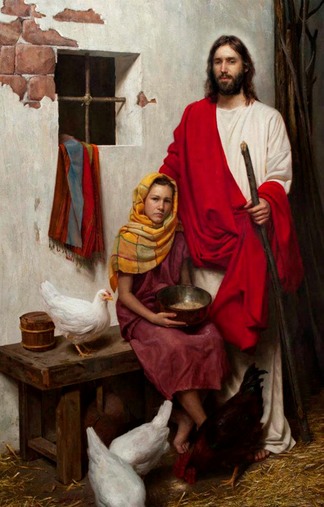
"As a Hen Gathereth," by Jeff Hein
Links:
Jeff Hein Demonstation and the Hein Academy of Art Fall Art Show, November 15, 2013, Salt Lake City, Utah.
Jeff was set up with what looked like an 8 x 10 panel. The model's name was Jake, and was about 25 years old. Jeff said that he was part Jewish, and had drawn him several times for use in one of his Biblical paintings.
Chairs were provided and there seemed to be about 25 people attending at the beginning of the demonstration. Jeff explained some things about his materials and thinking process as he started. He accepted questions throughout his demonstration, but did admit that each time he did so, it broke his concentration. I appreciate knowing that the process of creating art is one that should be completed, for the most part, without talking or conversation.
Frankly, I'm always amazed at these demonstrations. I know he is working with years of experience behind him, but it seems so natural and effortless. I always feel quite a few twinges of jealousy when watching him work. I really like the painterly look of his work. The likeness is totally there, but it is not "photographic" at all, it is very expressive and looks like handmade art -- not a photograph.
I made of few notes of some his thoughts and statements, they're below.
-Simplify.
-Combine shapes.
-General to specific.
-By working slow, you actually work faster. A lot of painting time is fixing mistakes that could have been avoided by working more slowly and carefully.
-Careful decisions.
-If you're having too much fun, you're probably doing something wrong.
-The journey is painful.
-Paint can be so three-dimensional.
-Filberts and rounds.
-Spontaneous marks.
-Color mosaic of the face.
-Working from life when the subject is a young child is terribly difficult.
-Has had animals in the studio, using them as models -- working from life.
-Loves the interaction with the model.
-Turn the form.
-Soft edges -- everything a blur.
-I try to do everything [in terms of drawing] in the hardest way possible.
-I own more photography equipment than some professional photographers.
-Grid drawing from a photo is the abominable sin.
-I believe in the exercise (drawing).
-I like pain.
-I dread working from photos.
-Block-in -- putting it together like a puzzle.
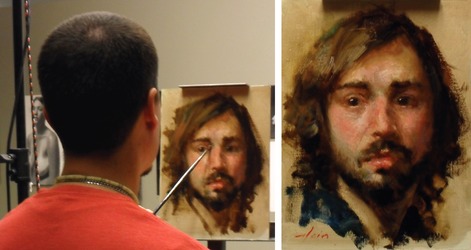
Links:
Rose Datoc Dall, Lunch and Learn Portrait Demonstration, Deseret Book, December 14, 2013, Salt Lake City, Utah.
I attended a "Lunch and Learn" portrait demonstration by Rose Datoc Dall on December 14, 2013 at Deseret Book in Salt Lake City, Utah. I found her to extremely friendly, personable, enthusiastic, humble, and self-deprecating. She set up a live model, and gave a portrait painting demonstration. She explained her process, took questions, and stopped to sign prints -- all at the same time. A true multi-tasker.
A few notes that I made:
-To get a likeness, draw from the same point of view.
-Uses maquettes and often sculpts her own models to use as drawing and painting reference.
-Uses "oil bars" for quick coverage, uses oil bars from R&F Pigments.
-Hard edges -- she likes them.
-Works form the outside in.
-Scans back and forth to get a likeness.
-Angled brushes -- edges and control.
-Squint to simplify.
-Dark / Medium / Light.
-No black.
-Step back.
-Takes pictures of art in progress.
-Uses a mirror to reveal distortions.
Below is her ad for the eveît, a photo I took during her demonstration, and a drawing I made during the demonstration.
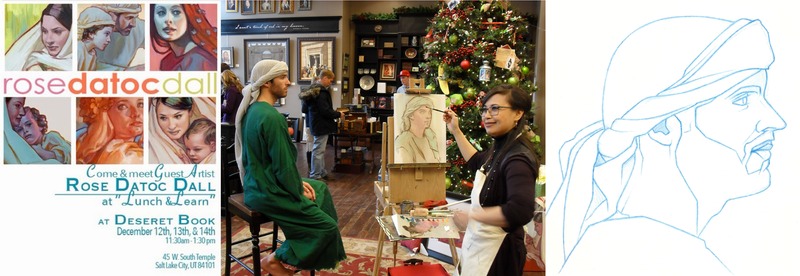
Links:
